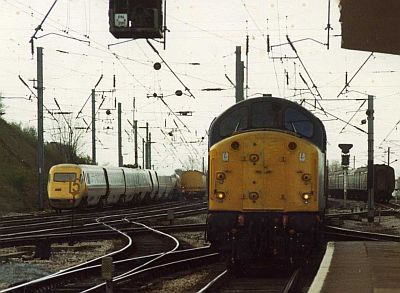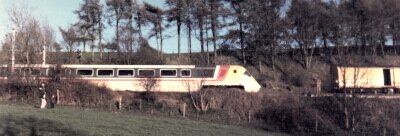APT
derailment
|
The nose of the broken down APT at Yealand.
18th April 1980. |
One of the trailer
car axles had been mis-assembled, and the ring of bolts that held the two halves of the
hydrokinetic braked axle had come apart, derailing itself.
Temporary repairs were undertaken, and then the train was moved to the Carnforth
"Up" loop, where it remained for most of the 19th April, whilst further repairs
were made.The train was still at Carnforth at 18:20.
All three P-Trains were temporarily withdrawn while every axle was checked.
On April 1980 I travelled on an advertised day excursion from Loughborough to the Ravenglass and Eskdale Railway. The trip also included a stopover at Carnforth for a visit to the steam centre. I stayed on Carnforth station to photograph main line traffic. As we arrived from the south I noticed a derailed APT in the loop south of the station. As we passed I couldn’t get a decent photograph as a coach from the rescue train obscured the bulk of the mishap. Whilst it was probably sensible for the coach to be positioned there, I couldn’t help but feel that it was strategically placed to prevent viewing of the mishap from passing trains! BR certainly wouldn’t have relished a picture of Britain’s new wonder train gracing the front of the daily papers in such a predicament!Thanks to:-
John Lancaster, Ron Herbert, David H,
Kit Spackman, Andy, Paul Leadley (APT-E Conservation & Support Group)
Rob Latham, APT-P Support Team, The Railway Age, Vernon Way, Crewe, CW1 2DB
For their help in researching this information.

My notes on the back of the picture state that the approaching loco in the foreground was 40083. To the right of this is the stock of our train waiting to take us forwards later in the day to Ravenglass (out of interest my notes also state that we used three different loco’s at Carnforth that day – arriving initially behind 47196, going to Ravenglass and back behind 40117 and finally departing for home with 85020 – we swapped engines a fourth and final time at Crewe with 46002 taking us on to Loughborough)
Craig Simmons
| Home | Top | Accidents |
| http://www.carnforth-station.co.uk | webmaster(at)carnforth-station.co.uk |
